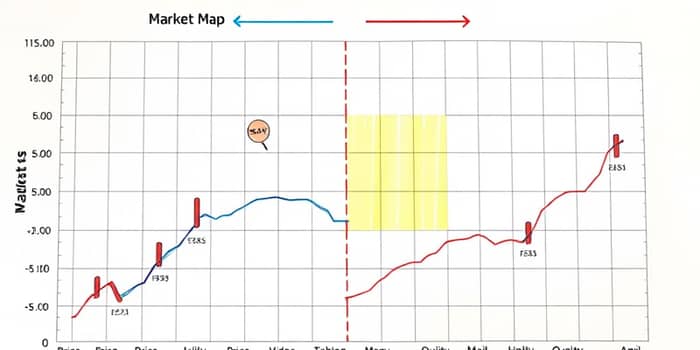In today’s accelerating business landscape, understanding where you stand—and where you can go—is critical. A market map offers that strategic compass.
By translating data into a visual grid, you can spot untapped market segments and allocate resources where returns are highest.
What Is a Market Map?
A market map (or market mapping) is a visual representation of a company’s position within a specific competitive landscape. It usually plots key attributes along two axes—such as price versus quality or innovation versus support—to show where brands cluster and where gaps exist.
This graphic tool helps decision-makers quickly compare offerings and understand which segments are overcrowded, which are ripe for entry, and which are at risk of saturation.
Why Use Market Maps?
Market mapping is more than a chart—it drives strategic insight. These benefits include:
- Improved strategic focus by concentrating on the most promising segments.
- Risk mitigation through early identification of volatile or crowded markets.
- Efficient resource allocation for capital, personnel, and technology.
- Stronger competitive advantage by targeting underserved niches.
- Data-driven decision support for expansion, innovation, or divestment.
- Informed partnerships and acquisitions aligned to strategic goals.
How to Build a Market Map
Creating a market map follows a structured process. Each step sharpens your strategic lens.
- Define clear objectives—Are you mapping for new product launch, pricing strategy, or competitive positioning?
- Identify the market and competitors—Gather current data on revenue, growth rates, product features, and geographic reach.
- Choose relevant axes such as price, quality, specialization, innovation, or service level.
- Segment your audience by demographics, geography, psychographics, behavior, and needs.
- Plot competitors and your offerings on the grid to visualize clustering, saturation, and white space.
- Analyze gaps and opportunities—Look for low-competition, high-demand areas ready for entry or disruption.
- Assess the regulatory and competitive landscape—Identify barriers, compliance issues, and direct threats.
- Plan implementation with tailored market entry strategies, pricing, messaging, and campaigns.
- Set SMART goals and develop an action plan with timelines, responsibilities, and metrics.
Sample Market Map Axes
Market Mapping in Practice
Consider a tech startup developing a wearable health device. By mapping price versus service support, they discovered an underserved mid-range band where customers wanted premium support but couldn’t afford top-tier pricing.
Armed with this insight, the company designed a subscription-based support package that fit this gap, capturing a share of customers disillusioned by expensive alternatives.
Turning Maps into Action
A market map alone doesn’t deliver profit—your action plan does. After mapping, advance with strategic clarity:
- Market Entry Strategies: Decide between direct investment, licensing, franchising, joint ventures, or digital channels.
- Product Localization: Adapt features, messaging, and pricing to match segment preferences and cultural norms.
- Targeted Campaigns: Craft marketing and sales initiatives that resonate with each mapped cluster.
- Competitive Pricing: Set price points that maximize value perception and margin potential.
- Monitoring Systems: Establish KPIs and dashboards to track market shifts and campaign performance.
Potential Pitfalls and Best Practices
While powerful, market mapping can mislead if not managed carefully. Watch out for:
Data inaccuracies—Outdated or skewed information can distort your map and lead to poor decisions.
Overlooking dynamics—Market landscapes shift quickly; update your maps regularly to reflect new entrants, changing preferences, or emerging technologies.
Ignoring regulatory risks—Opportunity gaps can coincide with high compliance barriers that stall execution.
Resource misalignment—Ensure identified opportunities match your organization’s capacity and core competencies.
Tools and Resources
Your market mapping toolkit should include:
- Graphing and design software such as Excel, Adobe Illustrator, or specialized mapping tools.
- Market research databases like Gartner, Statista, or IBISWorld for competitive intelligence and demographic data.
- Customer surveys, interviews, and focus groups to validate qualitative insights.
- Continuous learning through industry reports, webinars, and expert networks.
Action Checklist for Readers
- Define your map’s primary objective and measurement criteria.
- Compile up-to-date competitor and customer data from reliable sources.
- Select meaningful axes that reflect value drivers in your market.
- Plot offerings, identify gaps, and prioritize opportunities by potential ROI.
- Develop a SMART action plan with clear milestones and accountability.
- Monitor performance and update your map at least quarterly.
Conclusion
A well-crafted market map is both a mirror and a roadmap. It reflects your current standing and illuminates the path to sustainable profitability. By combining rigorous data analysis with creative insight, teams can chart courses through complex landscapes, target the right audiences, and seize emerging opportunities.
Embrace market mapping as an ongoing strategic practice. With each update, you refine your vision, sharpen your competitive edge, and move confidently toward your next growth milestone.






